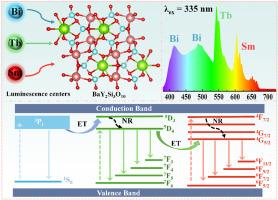Study on the structure, energy transfer, and color-tunable photoluminescence of the stable BaY2Si3O10: Bi/Tb/Sm phosphors
IF 3.6
3区 物理与天体物理
Q2 OPTICS
引用次数: 0
Abstract
With the growing concern about energy consumption, white light-emitting diodes(wLEDs), as the fourth generation of lighting sources, are highly scrutinized by researchers. A series of Bi3+/Tb3+/Sm3+ (co)doped BaY2Si3O10 phosphors were prepared by traditional solid-state method, and the phase purity was analyzed by X-ray diffraction. In this work, Bi3+/Tb3+/Sm3+ theoretically occupies the Ba/Y sites, and this conjecture is also proved by spectral analysis. Under near ultraviolet (nUV) light excitation, Bi3+/Tb3+/Sm3+ is respectively used as the blue (3P1 → 1S0)/green (5D4 → 7Fj)/red (4G5/2 → 6Hj) luminescence center. Due to the energy transfer (ET) efficiency between Bi3+/Sm3+ is not ideal, Tb3+ is introduced as a bridge to improve the ET efficiency of the whole system to achieve spectral tunability and application in wLEDs. And at different excitation wavelengths, Bi3+ emits a wide range of blue to cyan light because it occupies two cation sites. We selected a proper excitation wavelength and obtained an emission spectrum covering the whole visible region. The CIE color coordinates (0.3487, 0.3313), the correlated color temperature (CCT, 4773.61 K), quantum efficiency (QE, 47.62 %), and thermal stability (T50 = 537 K) of BaY2Si3O10: Bi3+/Tb3+/Sm3+ are discussed in depth, Lu3+ was used instead of Y3+ to improve the thermal stability of BYS. Its excellent luminescence performance indicates that this phosphor has potential applications in nUV wLEDs.

稳定的 BaY2Si3O10:Bi/Tb/Sm 荧光粉的结构、能量传递和颜色可调光致发光研究
随着人们对能源消耗的日益关注,白光发光二极管(wLED)作为第四代照明光源受到研究人员的高度关注。采用传统固态法制备了一系列 Bi3+/Tb3+/Sm3+(共)掺杂 BaY2Si3O10 荧光粉,并通过 X 射线衍射分析了其相纯度。在这项工作中,Bi3+/Tb3+/Sm3+ 理论上占据了 Ba/Y 位点,这一猜想也通过光谱分析得到了证实。在近紫外光(nUV)激发下,Bi3+/Tb3+/Sm3+ 分别作为蓝色(3P1 → 1S0)/绿色(5D4 → 7Fj)/红色(4G5/2 → 6Hj)发光中心。由于 Bi3+/Sm3+ 之间的能量转移(ET)效率并不理想,因此引入 Tb3+ 作为桥梁,以提高整个系统的 ET 效率,从而实现光谱的可调谐性并应用于 wLED。而在不同的激发波长下,Bi3+ 由于占据了两个阳离子位点,会发出从蓝色到青色的各种光线。我们选择了合适的激发波长,得到了覆盖整个可见光区域的发射光谱。我们深入讨论了 BaY2Si3O10: Bi3+/Tb3+/Sm3+ 的 CIE 色坐标(0.3487, 0.3313)、相关色温(CCT, 4773.61 K)、量子效率(QE, 47.62 %)和热稳定性(T50 = 537 K),并用 Lu3+ 代替 Y3+,以提高 BYS 的热稳定性。其优异的发光性能表明,这种荧光粉具有在 nUV wLED 中应用的潜力。
本文章由计算机程序翻译,如有差异,请以英文原文为准。
求助全文
约1分钟内获得全文
求助全文
来源期刊

Journal of Luminescence
物理-光学
CiteScore
6.70
自引率
13.90%
发文量
850
审稿时长
3.8 months
期刊介绍:
The purpose of the Journal of Luminescence is to provide a means of communication between scientists in different disciplines who share a common interest in the electronic excited states of molecular, ionic and covalent systems, whether crystalline, amorphous, or liquid.
We invite original papers and reviews on such subjects as: exciton and polariton dynamics, dynamics of localized excited states, energy and charge transport in ordered and disordered systems, radiative and non-radiative recombination, relaxation processes, vibronic interactions in electronic excited states, photochemistry in condensed systems, excited state resonance, double resonance, spin dynamics, selective excitation spectroscopy, hole burning, coherent processes in excited states, (e.g. coherent optical transients, photon echoes, transient gratings), multiphoton processes, optical bistability, photochromism, and new techniques for the study of excited states. This list is not intended to be exhaustive. Papers in the traditional areas of optical spectroscopy (absorption, MCD, luminescence, Raman scattering) are welcome. Papers on applications (phosphors, scintillators, electro- and cathodo-luminescence, radiography, bioimaging, solar energy, energy conversion, etc.) are also welcome if they present results of scientific, rather than only technological interest. However, papers containing purely theoretical results, not related to phenomena in the excited states, as well as papers using luminescence spectroscopy to perform routine analytical chemistry or biochemistry procedures, are outside the scope of the journal. Some exceptions will be possible at the discretion of the editors.
 求助内容:
求助内容: 应助结果提醒方式:
应助结果提醒方式:


